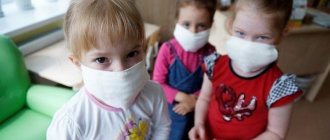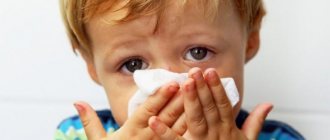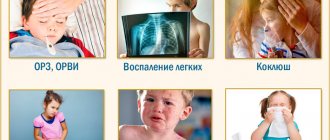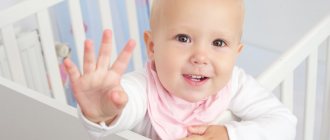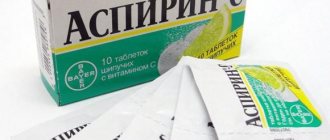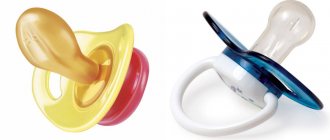- The benefits of walking in the fight against viral infection
- How to walk properly when you have ARVI
- Risks from walking with ARVI
- Restrictions for walking when infected with a viral infection
Most often, a sick child completely disappears from public life: he does not appear in kindergarten or school, or goes out into the yard for a walk. Only sometimes can you see his sad face in the window of the apartment, from where he sadly looks at the games of other children.
Even twenty years ago, it was believed that a sick child should be surrounded with warmth; parents were afraid to open the window again, did not allow them to take off woolen sweaters and socks, and carefully wrapped them in huge scarves so that the child would recover faster. No one even thought about going for a walk with a child sick with ARVI.
However, now more and more often you can see a child walking away from other children, coughing or blowing his nose into a handkerchief carefully offered to him by his parent.
Is it possible for a child to go for a walk if he has ARVI? Or will this lead to a worsening of his condition?
The benefits of walking in the fight against viral infection
Surprisingly, leaving a child in a warm, unventilated room during a viral infection is much more dangerous than taking him outside for a walk. What are the benefits of walking with a sick child?
- Sun. Ultraviolet rays naturally prevent viruses from reproducing. This does not mean that a child with a cold should be immediately taken to the sun and constantly kept in sunlight. It would be optimal to walk in the shade of trees, where there is diffused sunlight.
- Air. Fresh air is much healthier than the stale air of an apartment. It saturates the cells with oxygen, relieves headaches, makes it possible to fall asleep after a walk with a sweet dream, thereby speeding up recovery. Fresh air also helps to cough up mucus, which is why many children, when leaving home for the first time after an illness, begin to cough heavily and for a long time. There is nothing wrong with this - the air helps the lungs get rid of mucus. It is optimal to walk in a coniferous forest, since the phytoncides released by coniferous trees not only destroy viruses, but also prevent their reproduction. And you can ventilate the apartment while your child is walking without fear of drafts.
- Movement. During movement, even walking, the child’s blood circulation and metabolism improve, and accordingly, the body quickly begins to get rid of harmful substances and recovers.
- Mood. Sun, air, bright colors, change of scenery, communication with nature, new experiences - all this will add positive emotions, so necessary for recovery.
- Walking also strengthens the immune system and helps fight the virus faster.
Of course, this does not mean that a barely ill child with a temperature of 38 °C should immediately be taken out for a walk in the forest to breathe the healing pine air. There are rules for walking during ARVI, and in addition it is always advisable to consult with your doctor, because each situation is individual.
How to properly walk during ARVI, advice from Komarovsky E.O.
The good doctor, adored by many mothers, draws attention to the great benefits of spending time for sick children outside, since fresh, clean air heals better than medications.
In his opinion, walking during an acute respiratory viral infection is extremely important if the baby’s temperature is normal, there are no chills, fever, or weakness. But games in nature should be calm, without unnecessary movements. And clothes must be appropriate for the season.
The main recommendations of the luminary of Russian pediatrics, Komarovsky, on the conditions for carrying out walks during ARVI are as follows:
- If you have a runny nose, before going for a walk, you should clear your sinuses so that you can breathe properly, not through your mouth.
- It is forbidden to wrap the child in multi-layered clothing to avoid overheating and sweating.
- It is also impossible to allow hypothermia due to an insufficiently warm jacket (pants, boots).
- You should temporarily limit communication with strangers if the disease is contagious to others. In addition, with close contacts, the baby is at risk of contact with carriers of a bacterial infection.
- If the air is cold (up to –10 degrees), you need to start walking for 5 minutes, gradually increasing the walk to 15 minutes.
- The permissible time period for walking during ARVI in autumn, spring, summer, if the weather is warm: from half an hour to 40 minutes, no more at a time. In light rain - 15 minutes.
- It is better if aerotherapy procedures are carried out twice a day, especially if the child suffers from bouts of unproductive coughing. If the air is humid, the mucus from the respiratory tract begins to separate faster.
- In cases of ARVI, you should not take your baby out for a walk under unfavorable climatic conditions.
- The sun's rays actively destroy viruses, but let the exposure to ultraviolet radiation be diffuse: through the foliage of bushes, trees, and the canopy of the veranda.
How to walk properly when you have ARVI
First of all, you need to understand that at temperatures above 37.4 °C, walking is undesirable - most likely, they will only bring harm.
At this temperature, a walk will not be a joy: even an adult will feel discomfort and, instead of admiring nature, will want to sit down, wrap himself in a blanket, drink hot tea, and for a child the need to move can be a serious test. You should postpone health-improving walks until the moment when the temperature subsides and there are only residual effects - runny nose, cough, sore throat.
How to properly walk a child with ARVI:
- With pleasure. During illness, you should never add negative emotions. If a child does not want to go for a walk, and parents force him to get dressed, get ready, and go out, this will ultimately lead to hysteria and subsequent resentment. Negative emotions will seriously impede recovery, and sometimes, due to stress, fever and other symptoms of ARVI may return. A walk in this case will not bring any benefit. In addition, if a child objects to going outside, there is a chance that physical activity is difficult for him and it is too early to go for a walk.
- Without friends and acquaintances. Unfortunately, communication with other children, their parents, and even people you meet by chance is dangerous for both parties. A patient with ARVI can infect other people within 5-7 days, so for healthy people such an encounter is practically a guarantee of an upcoming illness. And for a sick child, communication is dangerous, since his immunity is suppressed, and any additional injection of viruses or bacterial infection will lead to a new round of illness. Therefore, it is better to choose places for walks away from playgrounds and crowds of people, adequately assessing the weather conditions. Despite the words of the famous song, nature has bad weather. Rain, thunderstorms, strong gusty winds, very low or too high temperatures, hail, heavy snowfall, deep puddles after rain - all these are reasons to stay at home and not go on a planned walk. Even a healthy person can feel unwell outside in such weather, so you should not endanger a recovering child.
- Dress your child according to the weather. Wrapping a child in several sweaters is very dangerous, as is allowing hypothermia. Therefore, clothing should be ordinary, appropriate to the weather conditions. You can take an extra jacket or scarf just in case - they can come in handy if it gets colder. Shoes are also important - they should be waterproof, reliable and warm.
- Breathing through the nose. It is impossible to cool the throat or allow it to come into contact with bacteria and viruses. Therefore, even if the runny nose has not yet passed, it is advisable for the child to blow his nose before leaving the house and take paper napkins with him. There is another alternative that partially replaces a walk through a coniferous forest with its disinfecting air - use essential oils. For example, a few drops of Breathe® Oil on a child’s scarf during a walk will not only promote his recovery, but also protect him from additional bacterial and viral infections. Thanks to the combination of essential oils that make up the Breathe® Oil, it will become easier for your child to breathe!
If a child gets sick during the flowering season or the wind raises dust, it is advisable to put a protective mask on the child outside to prevent potential allergens from entering the body during a period of low immunity.
Is it possible to walk if you have ARVI?
is a general term that includes a group of similar respiratory diseases that occur due to viruses. There are different types of viruses, there are a huge number of them, the disease can be caused by one group of viruses or several at once.
Quick registration Get 5% discount on your first order!
Each child will have a different course of the disease, but the main symptoms will be similar: fever, runny nose, sore throat, cough. The severity of certain signs depends on the amount of pathogen that has entered the body and on immunity. If the immune system is normal, then “good” blood cells (they are called phagocytes) will immediately rush to fight “bad” viruses. They will also give a signal to other defenders (leukocytes and the complement system) to rush to the rescue.
If the defenders win the battle, the disease will end before it even begins. Has it ever happened to you that in the evening you feel chills, headache, fatigue, you just want to sleep, but in the morning you get up in the morning and it’s as if you never felt bad? And the defender cells tried their best, threw all their strength into eliminating the enemy and rose to the occasion. But this is the ideal option.
But if there were many more attackers than defenders, the viruses broke through the first barrier on their way and continued to attack the body, then the disease develops progressively, since in order to retaliate the body needs to send into battle the most formidable weapon - antibodies that absorb antigens produced by viruses. But you won’t be able to get this weapon simply by waving a magic wand; it needs to be made, and it takes time. So the illness lasts for a week or more, since the defenders were unable to prevent the attack at the very beginning.
► Read the article “10 Rules for Strengthening the Immunity” in our blog.
A viral infection most often occurs with fever, chills, the child complains of headache, dizziness, and lack of appetite. Clear nasal discharge appears, the child often sneezes and feels cold.
Treatment at the onset of the disease is only symptomatic:
- ► antipyretics at high temperatures, ► rinsing the nose with saline solutions, ► frequent and abundant drinking.
Lack of appetite is a good sign, since the body does not want to spend energy on digesting food, it only wants to spend energy on fighting viruses. It is ideal when the child understands that he is not feeling well and he lies down, rests or sleeps. This way it helps the body not to waste energy on active actions.
Of course, in the active phase of the disease, walking with the child is contraindicated. But he needs fresh, humidified air, so we ventilate the room more often and turn on a humidifier or air washer. During ventilation, the child should not be in the room. A draft is prohibited for a weakened body!
Usually, on the third day of the home regime, the child’s condition noticeably improves, the temperature returns to normal, appetite and interest in others appear. It’s clear that the baby will want to go for a little walk outside. Indeed, when the acute period of illness ends and the recovery phase begins, walks in the fresh air are even beneficial for the child. You need to start walking for 15-20 minutes a day and take into account the weather conditions: in a sharp wind and at an air temperature below 10 degrees, walks are contraindicated for a recovering child.
If your baby has a wet cough, this is not a reason to refuse walks. Moreover, in the fresh air, the blood supply to the bronchial mucosa improves, thereby improving the discharge of sputum, and coughing is only a mechanism for removing mucus from the bronchi.
If a child under 1 year of age falls ill with ARVI, then it is necessary to closely monitor him, since at this age a rapid deterioration in his condition is possible. The baby’s immune system is still developing and getting stronger, so it still doesn’t cope well with viruses. If your baby only has a runny nose, you can and should go for a walk in good weather conditions. If your baby has a hoarse voice, difficulty breathing and a frequent cough, you should hold off on walking for now and be under the supervision of a pediatrician.
► Read the article “7 types of mothers through the eyes of a pediatrician” in our blog and find out what kind of mother you are.
Each child’s body is individual, as is the immune system, so this article provides only general recommendations. If the baby is recovering, feels well, is full of strength and energy, let him go for a walk. But if any complaints still persist or the child simply says that he gets tired quickly, it is better to undergo further treatment, gain strength and then boldly go for a walk and breathe fresh air.
The most relevant and useful information for modern parents is in our newsletter. We already have over 30,000 subscribers!
Do you walk with your child if he has a runny nose or cough? Share in the comments!
Risks from walking with ARVI
No one is immune from risks, so it is best to check with your doctor in advance whether a child with ARVI should go for a walk. If the doctor strictly recommends bed rest, walking is undesirable and even dangerous. Risks arise due to non-compliance with the rules:
- Wet clothing can increase the risk of pneumonia.
- Improper breathing with an open mouth due to a runny nose can lead to sore throat, bronchitis, tracheitis, and will increase the risk of new viruses and bacteria entering the body.
- Communicating with other people while walking also carries the risk of contracting another infection, which will develop very quickly against the background of weak immunity.
- If a child is dressed too warmly or begins to move too actively during a walk, he may sweat, which will provoke hypothermia and a new round of illness.
- Hypothermia will also not benefit the patient, so clothing should be suitable for weather conditions.
It is extremely important to monitor the child's reaction. If his face is red or pale, and his hands and neck are too hot or too cold, it is advisable to go home as quickly as possible.
Restrictions for walking when infected with a viral infection
Restrictions for walking during ARVI are as follows:
- body temperature above 37.5 °C (you can go for a walk only after there has been no temperature for two days in a row);
- fever, chills, severe feeling of weakness;
- complications of ARVI;
- prescribed bed rest;
- severe allergy to pollen during the flowering period;
- severe weather conditions: heat, severe frost, precipitation (rain, snow) or strong wind.
If there are no restrictions, the child can be allowed to take a walk in the park or forest, breathe in the healing air, exposing his face to the sun, enjoying a wonderful day, protecting against re-infection with the help of Breathe® essential oils.
Let your child recover with pleasure! THIS IS NOT AN ADVERTISING. THE MATERIAL WAS PREPARED WITH THE PARTICIPATION OF EXPERTS.
